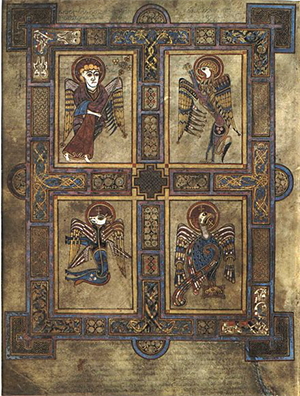The Book of Kells is one of the most famous medieval religious books in history. The illuminations of this 9th-Century Irish work are perhaps its most famous feature.
It is called the Book of Kells because it resided in Kells, Ireland, from the early 9th Century, after being spirited out of its place of origin, a monastery on the Isle of Iona, off Scotland. The Vikings raided that monastery, founded by the famous Columba, in A.D. 806 and killed 68 monks; the survivors took the Book with them to Kells.

That period of residency has two exceptions: A theft in 1007 resulted in some water damage and the removal of the cover, but the rest of the book was intact; and the Catholic Church secreted the book in 1541 to keep it from being destroyed during the English Reformation and handed it over to Trinity College in Dublin in 1661.
The 680 vellum pages (in the form of 340 folios) are filled with illuminations of words, people, and stories and are the book's most famous element. The illuminators, as the artists were known, used as many as 10 colors, some of which required expensive materials to produce. Some pages contain only illustrations. This was not an uncommon practice. Other such well-known books include the Book of Darrow (also from Ireland) and the Lindisfarne Gospels (from England).
The content of the book is the first four books of the Christian Bible's New Testament, the Four Gospels (Matthew, Mark, Luke, and John), as well as a number of indexes, summaries, and cross-references–all written in Latin. Many of the pages also contain Celtic artistic elements. Some pages are blank, and the last part of the Gospel of John is missing. The cover was encrusted with gold and jewels, which could be a reason for the 11th-Century theft.
Scholars have attempted to rebind the book several times through the years, with varying degrees of success. A 1953 rebinding created four separate volumes, two of which are on display at Trinity College in Dublin.